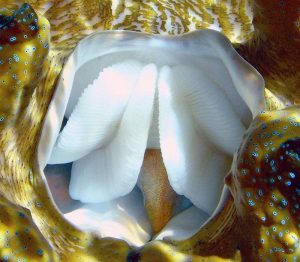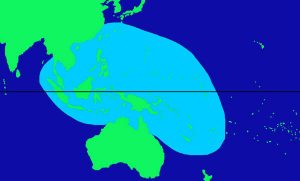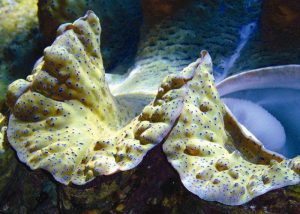 All of the species of clams in the family Tridacnidae are commonly called giant clams, but they actually vary a great deal when it comes to how large they can grow. For example, a large specimen of Tridacna crocea may be only four inches in length when measuring the shell from end to end, while its close cousin, T. maxima, often reaches eight inches in length. Tridacna gigas, on the other hand, is the real giant of the bunch, which commonly reaches lengths greater than two feet. In fact, the record holder was four and a half feet from end to end!
All of the species of clams in the family Tridacnidae are commonly called giant clams, but they actually vary a great deal when it comes to how large they can grow. For example, a large specimen of Tridacna crocea may be only four inches in length when measuring the shell from end to end, while its close cousin, T. maxima, often reaches eight inches in length. Tridacna gigas, on the other hand, is the real giant of the bunch, which commonly reaches lengths greater than two feet. In fact, the record holder was four and a half feet from end to end!
With this in mind, it should be obvious that T. gigas is not a clam for many reef hobbyists to consider keeping, despite their hardiness and good looks. But, for those with large tanks (and very bright lights), such clams can certainly be breathtaking additions. So, I’ll fill you in on this species, and will cover its basic biology, how to identify it, and its aquarium needs.
Basic Information
Tridacna gigas (which I’m going to just call gigas from here on out) is found in the eastern Indian Ocean and west Pacific Ocean, ranging from Thailand and western Australia eastward all the way over to Micronesia. The species’ range also extends northward to the southern islands of Japan and south to the Great Barrier Reef and New Caledonia. However, all giant clams, and particularly big gigas specimens, are eaten by many people in Asia and the Pacific Islands and have been over-fished in many parts of their natural ranges. So, there are spots here and there where gigas has been completely wiped out, with Okinawa being one example. After all, they’re essentially big pieces of meat that live in shallow water, are easy to find, and can’t swim away.
Gigas Range
Regardless, within its range, gigas is commonly found on reef flats and in shallow lagoons, with many of them living in intertidal areas where they may be completely exposed to air at low tide. That might sound odd, but all species of giant clam have the ability to live out of water for at least a few hours. So, being left high-and-dry for a while during low tide is not an issue for them.
Still, gigas isn’t always found in such shallow waters, as I’ve found them living at various depths all the way down to about 50 feet, and some individuals can apparently live even deeper than that, as Knop (1996) reported that they can live down to about 65 feet. Regardless of the exact depth, they’re usually found on sandy bottoms or on coral rubble, but may be found amongst live corals and on limestone hard bottoms at times, as well. So, they don’t seem to be too picky about what they live upon.
Again, when it comes to maximum size, the largest specimen reported in the scientific literature was an unbelievable 4.5 feet long from one end of its shell to the other (Rosewater 1965), certainly making it the largest species of clam in the seas. This specimen isn’t the record holder for weight though, as a somewhat shorter (but apparently fatter) gigas weighed in at 734 pounds (Knop 1996). Thus, gigas is the heaviest clam, too.
In addition to its staggering potential size, gigas is also an odd clam because, like all the members of the family, it harbors large populations of zooxanthellae. These single-celled photosynthetic algae live in the tissues of a host clam within a specialized system of tubes, and when given enough light, they can make far more food than they need for themselves. The extra food (in the form of carbon and energy-packed glucose) is then given to the clam host, which is the same thing that occurs within most reef-dwelling corals.
Under optimal conditions, these zooxanthellae are constantly multiplying within a tridacnid, and some of these live algal cells can be digested by specialized amoeboid cells within the host, too. So, a host clam can rely on its zooxanthellae for more than just sugars, and is considered to be a “farmer” to some degree, as it can consume these surplus zooxanthellae grown inside its body.
Like all other giant clams, gigas can also absorb nutrients directly from seawater. Their mantle is covered by a specialized tissue that is very effective at taking in dissolved nutrients like ammonia, nitrate, phosphates, and many other nutrients found in seawater. So, here they have a third means of nutrient acquisition, with one more to go.
Lastly, all giant clams can filter-feed, as they can eat fine particulate matter strained from surrounding waters. They all have very specialized gills, which not only work to exchange carbon dioxide and oxygen, but can also act as sieves that can collect such particles from the water. A clam basically pumps water into its body chamber, then it flows over the sieve-like gills and out the other side of the body chamber, minus some particles. These collected bits are primarily phytoplankton (single-cell or tiny multi-celled algae), zooplankton (single-cell or tiny multi-celled animals), and detritus (particles that are mostly fish wastes with bacterial coatings).
Identification
When it comes to identification, gigas is actually pretty easy to distinguish from its cousins once you’ve seen a few. However, just to make sure that you don’t mistakenly buy a clam that can grow to a few feet across instead of a few inches across, here’s some key information.
Gigas’ mantle tissue is most commonly yellowish to green to brown, and is dotted by eyes that are usually bordered by a blue, blue-green, or green ring. These eyes are sometimes erroneously called iridophores, but iridophores are actually light-reflecting bundles of cells, not big dark spots. It’s the blue-green rings themselves that contain large numbers of iridophores, with the dark spots being simple eyes.
However, on occasion you may find a gigas that is dark purple, orange, or another color, and it’s also important to note that gigas typically has significant areas of its mantle that are rather translucent and lighter-colored, or even colorless. These unpigmented, zooxanthellae-free parts of the mantle are typically seen as meandering stripes and patches, or numerous small blotches, which are prominent in the flat area of the mantle between the valves.
The inhalent siphon, where water enters the body chamber, is typically large and is often held wide-open, enough so that the gills can be plainly seen. The inhalent siphon also lacks tentacles, being smooth around its margin. The exhalent siphon, where water leaves after passing through the body chamber, is usually hose-like and is often pointed away from the inhalent siphon, as well.
Mantle extension is variable for gigas, as some individuals have very large mantles, which reach out relatively far, while others extend their mantle tissue only to the shell margin, or just a little over its edge. The texture of the mantle is variable, as well. Smaller clams and those with well-extended mantles tend to have smooth mantle surfaces that sometimes have crenulated or rough margins. But, many specimens have very lumpy mantles that look much thicker and, for lack of a better term, “meatier”.
The shell is always grayish-white, and juveniles usually have a hinge that is about 1/2 the length of the whole shell, which is fan-shaped in outline. Larger individuals tend to get somewhat elongated though, and the hinge may increase to as much as 2/3 the length of the shell, which allows gigas to gape open exceptionally wide. The shell is also moderately inflated when small, but typically becomes more and more inflated as a clam grows, making gigas look rather fat for a clam.
The shell typically has four to six folds/ribs on each half too, four or five of which become very prominent. While they’re much lower-profile when the clams are young, as a gigas grows, the folds become more and more convex and broad. Regardless of size, there are no scale-like scutes on the shell of a gigas though, which are often seen on the shells other species. However, when they’re young they may have small semi-tubular structures near the base of shell, which are lost as they grow.
When small, each half of the shell (the valves) may be perfectly symmetrical to each other, having smooth curves that allow the shell to close very tightly. However, they lose this ability altogether as they grow larger. Over time, each valve develops three or four exceptionally large, pointed, finger-like projections, but these do not fit together with the projections on the opposite valve. Instead, they sit in a much larger and very open curve on the opposite valve when the shell is closed. Oddly enough, this means the shell can never close tightly and can’t hide the retracted mantle very well at all, as there’s always a sizeable gap left between the valves.
And lastly, gigas is a species of giant clam that typically lives attached to the substrate when very small, using a number of tough strands that protrude from an opening in the bottom of the shell. As they get larger and heavier they release this attachment though, as their own weight is typically enough to keep them in place. Accordingly, the byssal opening (where the threads emerge) is variable in size, but is generally relatively small in juveniles, becoming closed completely as an individual matures.
With all that said, about the only clam that can easily be confused with gigas by the unexperienced is T. derasa. When they’re young, both of these have shells that can look a lot alike, but gigas eventually develops those big finger-like projections on the valves and derasa won’t. Derasa’s shell can also close tightly at any size, but a moderate to large gigas shell won’t. Regardless, an easy and reliable way to figure out which is which at any size is to look for those little blue-green rings of iridophores around the randomly scattered eyes of a gigas, which no other species has. Additionally, you can look for the presence of tentacles around the inhalent siphon. Derasa’s siphon, with very few exceptions, is ringed with tentacles, some of which are branched and/or paddle-shaped. Conversely, gigas’ has no tentacles at all.

When they’re still small, the shells of gigas and derasa do look a lot alike. But, the soft parts are rather easy to differentiate.
Aquarium Care
As far as water quality goes, gigas will need the same type of environmental conditions that corals and other reef (aquarium) inhabitants require. Water quality should be the same as that needed to keep corals alive and well, and the only parameters requiring some particular attention are calcium and alkalinity.
Like stony corals, giant clams make their hard parts out of calcium carbonate, and need plenty of calcium to keep growing. A small gigas may not use that much, but as they get bigger and bigger, they can really start to suck the calcium up and rapidly deplete alkalinity, too. As they grow, new shell material isn’t added to just the edge of the shell, but is added to the inside, as well. So, the shell gets thicker and thicker, not just bigger and bigger, and it’s a big shell. Clam shell is also much denser than most any coral skeleton, so it takes a proportionally greater amount of calcium to produce it. What this means is that calcium and alkalinity need to be kept high, and should be monitored regularly, especially if you have a large specimen.
When it comes to current, it’s okay to expose a gigas to a low velocity surge, or to turbulent flow, but putting them in a position where a pump bathes them in a strong, non-stop linear current is not recommended. Basically, any sort of current that causes their extended soft tissue to fold upwards too much, or over onto itself all the time is bad, as is any current that makes one keep its mantle pulled into the shell. Thus, you can put a gigas anywhere you like in an aquarium with respect to current, as long as it doesn’t bring on either of these reactions. Yes, a gigas can take an occasional blasting that folds it up or makes it retract, but if it happens all the time, the clam can suffer from stress, or may even begin to starve from lack of light due to the lack of mantle extension.
As far as specific placement goes, all of the giant clams can be found living on hard substrates at times, like corals, the skeletons of dead corals, limestone, or other kinds of rock, and all but one (T. crocea) can also be found on coral rubble, and on sandy bottoms, too. This means that a gigas can be placed on either hard or soft substrates. Still, when they’re small in size they tend to attach themselves to hard bottoms, so it may be better to put them on a piece of rock, shell, etc. when they are small and let them do the same thing in your tank. Then, after they get big enough to stay in place due to their own weight, rather than their attachment, they will release their attachment. At that point, you can put them anywhere you like (as long as the current is okay, of course). I’m not suggesting you absolutely must to do this by any means, but I do recommend it since this is what they do in their natural habitat.
Gigas obviously needs bright lights in order for the zooxanthellae to do their job too, so proper lighting is critical. Very few hobbyists have successfully kept gigas specimens under high-output fluorescent lights in shallow tanks, so I strongly recommend that you use metal halide lighting. For one, you should never try to keep a gigas in a small/shallow tank in the first place, as it’ll certainly outgrow one, and it’s always better to have more light than is absolutely required, rather than not enough. Tridacnids that are under-illuminated will slowly starve to death over a period of months, without exception, thus you might think your lights are good enough only to find that they aren’t at a much later time. So, don’t take any chances. I’ll go ahead and throw it in here that you should not make the mistake of thinking that a gigas can make up for a lack of light by simply eating more particulate matter and absorbing more stuff from the water, either. It won’t work.
So, we get to feeding. There has been a long-running debate about whether the tridacnids can be self-sufficient and get by without the use of particulate/planktonic foods in aquariums, but I can assure you that they can – under the right conditions. In well-stocked aquariums, there is usually no shortage of dissolved nutrients, which a gigas can absorb. In fact, having more nutrients than are wanted is typically the rule in tanks, rather than not having enough, as long as there are plenty of fishes that are being fed. Any uneaten food will break down are release nutrients, and fishes give off both ammonia and phosphorus as waste products, too. There’s also some particulate matter drifting about in aquariums, some of which can be collected by tridacnids, as well. Thus, as long as you have sufficient lighting, and a good number of fishes, there shouldn’t be any need to add extra foods, like phytoplankton.
That’s not to say that a tridacnid can’t benefit from some extra particulate foods, or that they’ll just stop feeding altogether if given enough light to allow the zooxanthellae to really crank out a lot of food and such. But, the lighting and the presence of dissolved nutrients are, without a doubt, the keys to getting what they need to stay alive. Of course, I just covered this in much greater detail in the July issue (Fatherree 2010), so take a look at that article for more on feeding (or not feeding) giant clams if you need to.
With all that covered, the last thing to bring up is that they can grow fast, and obviously get big. Under optimal conditions, gigas is certainly the fastest growing of the giant clams, which can be great if you have a huge tank, or terrible if you have a relatively small one. Keep in mind that if you plan on having a gigas long term, it will need to be kept in a tank that is at least 18 inches wide, and will more than likely eventually need something even bigger than this. These clam are not suited for life in 55 gallon tanks, etc.
And that’s all I’ve got for now. If you want even more information about gigas and all of the rest of the tridacnids, pick up a copy of my book on the topic, Giant Clams in the Sea and the Aquarium. It includes lots of specific information about their biology, and all aspects of their aquarium care are covered, as well.
References
- Fatherree, J.W. 2010. Aquarium Invertebrates: Tridacnid Clams (Usually) Don’t Need to Be Fed in Aquaria. Advanced Aquarist’s Online Magazine, 9(7).
- Fatherree, J.W. 2006. Giant Clams in the Sea and the Aquarium. Liquid Medium, Tampa. 227pp.
- Knop, D. 1996. Giant Clams: A Comprehensive Guide to the Identification and Care of Tridacnid Clams. Dahne Verlag, Ettlingen, Germany. 255pp.
- Rosewater, J. 1965. The family Tridacnidae in the Indo-Pacific. Indo-Pacific Mollusca 1:347-396.







0 Comments